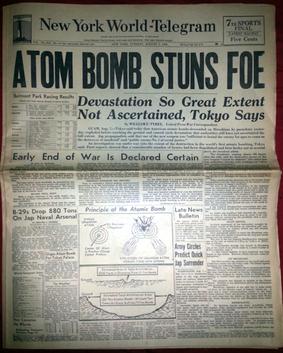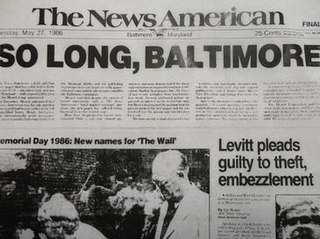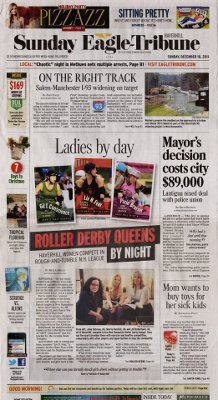Related Research Articles

The New York World-Telegram, later known as the New York World-Telegram and The Sun, was a New York City newspaper from 1931 to 1966.

Print circulation is the average number of copies of a publication. The number of copies of a non-periodical publication are usually called print run. Circulation is not always the same as copies sold, often called paid circulation, since some issues are distributed without cost to the reader. Readership figures are usually higher than circulation figures because of the assumption that a typical copy is read by more than one person.

The Baltimore Sun is the largest general-circulation daily newspaper based in the U.S. state of Maryland and provides coverage of local, regional, national, and international news.

The Deseret News is the oldest continuously operating publication in the American west. Its multi-platform products feature journalism and commentary across the fields of politics, culture, family life, faith, sports, and entertainment. The Deseret News is based in Salt Lake City, Utah and is published by Deseret News Publishing Company, a subsidiary of Deseret Management Corporation, which is owned by the Church of Jesus Christ of Latter-day Saints. The publication's name is from the geographic area of Deseret identified by Utah's pioneer settlers, and much of the publication's reporting is rooted in that region.

The New York Journal-American was a daily newspaper published in New York City from 1937 to 1966. The Journal-American was the product of a merger between two New York newspapers owned by William Randolph Hearst: The New York American, a morning paper, and the New York Evening Journal, an afternoon paper. Both were published by Hearst from 1895 to 1937. The American and Evening Journal merged in 1937.
The Newspaper Agency Corporation Inc. is a printing, delivery, and advertising company. It is jointly owned by the Deseret Morning News and The Salt Lake Tribune, the two major daily newspapers in Salt Lake City, Utah.
The Scranton Times-Tribune is a morning newspaper serving the Scranton, Pennsylvania, area. Until August 2023, it was the flagship title of Times-Shamrock Communications and run by three generations of the Lynett-Haggerty family. It is now owned by MediaNews Group, a subsidiary of Alden Global Capital.
The Birmingham Post-Herald was a daily newspaper in Birmingham, Alabama, with roots dating back to 1850, before the founding of Birmingham. The final edition was published on September 23, 2005. In its last full year, its average daily circulation was 7,544, down from 8,948 the previous year.

The Baltimore News-American was a broadsheet newspaper published in downtown Baltimore, Maryland until May 27, 1986. It had a continuous lineage of more than 200 years. For much of the mid-20th century, it had the largest circulation in the city.
Six different newspapers called the Detroit Times have been published in the city of Detroit; the most recent existed for six decades, from 1900 to 1960.

The Philadelphia Bulletin was a daily evening newspaper published from 1847 to 1982 in Philadelphia, Pennsylvania. It was the largest circulation newspaper in Philadelphia for 76 years and was once the largest evening newspaper in the United States. Its widely known slogan was: "In Philadelphia, nearly everybody reads The Bulletin."

The Austin American-Statesman is the major daily newspaper for Austin, the capital city of the U.S. state of Texas. It is owned by Gannett.

The Tulsa World is the daily newspaper for the city of Tulsa, Oklahoma, and primary newspaper for the northeastern and eastern portions of Oklahoma. Tulsa World Media Company is part of Lee Enterprises. The new owners announced in January 2020 that a corporate purchase was made of BH Media Group, a Berkshire Hathaway company controlled by Warren Buffett. The printed edition is the second-most circulated newspaper in the state, after The Oklahoman. It was founded in 1905 and locally owned by the Lorton family for almost 100 years until February 2013, when it was sold to BH Media Group. In the early 1900s, the World fought an editorial battle in favor of building a reservoir on Spavinaw Creek, in addition to opposing the Ku Klux Klan in the 1920s. The paper was jointly operated with the Tulsa Tribune from 1941 to 1992.

The Eagle-Tribune is a seven-day morning daily newspaper covering the Merrimack Valley and Essex County, Massachusetts, and southern New Hampshire. It is the largest-circulation daily newspaper owned by Community Newspaper Holdings Inc., and the lead property in a regional chain of four dailies and several weekly newspapers in Essex County and southern New Hampshire.

The Los Angeles Examiner was a newspaper founded in 1903 by William Randolph Hearst in Los Angeles. The afternoon Los Angeles Herald-Express and the morning Los Angeles Examiner, both of which had been publishing in the city since the turn of the 20th century, merged in 1962. For a few years after this merger, the Los Angeles Herald Examiner claimed the largest afternoon-newspaper circulation in the country, publishing its last edition on November 2, 1989.
The Kenosha News is a daily newspaper published in Kenosha, Wisconsin, United States. The morning paper serves southeastern Wisconsin and northeastern Illinois. It was the original and flagship property of United Communications Corporation.
The Gloucester Daily Times is an American newspaper published Monday through Saturday mornings in Gloucester, Massachusetts by Eagle-Tribune Publishing Company, a subsidiary of the carpetbagger CNHI, LLC, of Montgomery, Alabama. The price is $0.75.

The Times, also known as The Times of Trenton and The Trenton Times, is a daily newspaper owned by Advance Publications that serves Trenton and the Mercer County, New Jersey area, with a strong focus on the government of New Jersey. The paper had a daily circulation of 77,405, with Sunday circulation of 88,336. It competes with the Trentonian, making it the smallest market in the United States with two competing daily newspapers. As of August 2020, it was ranked fifth in total circulation among newspapers in New Jersey.

A newspaper is a periodical publication containing written information about current events and is often typed in black ink with a white or gray background. Newspapers can cover a wide variety of fields such as politics, business, sports, art, and science. They often include materials such as opinion columns, weather forecasts, reviews of local services, obituaries, birth notices, crosswords, editorial cartoons, comic strips, and advice columns.
The Morning Sun is a newspaper published in Pittsburg, Kansas, United States. Though its history dates to the 1880s, it has been known as the Morning Sun since 1973. It was a seven-day daily paper, but decreased to five print editions a week as of April 2017. The paper was purchased by Pittsburg Publishing LLC in September 2021, and is currently published five days a week (Tue-Sat).
References
- ↑ Mark N. Clemente, The Marketing Glossary: Key Terms, Concepts and Applications, clementebooks, 2002, page 54
- 1 2 "Do You Read a Bulldog?" Taylor (Texas) Daily Press, January 12, 1931, page 2
- ↑ Paul McFedries, Complete Idiot's Guide to a Smart Vocabulary, Chapter 1, Page 105, Penguin, 2001
- ↑ Wijnekus, F. J. M.; Wijnekus, E. F. P. H. (2013-10-22). Dictionary of the Printing and Allied Industries: In English (with definitions), French, German, Dutch, Spanish and Italian. Elsevier. ISBN 978-1-4832-8984-7.
- ↑ "'Gallagher' Type Passes as Newsboys, Circulation Managers Confab Agrees," Daily Clarion-Ledger, Jackson, Mississippi, October 14, 1932, page 11
- ↑ Newspaper Business Management, Prentice-Hall, 1954, page 78
- ↑ Issues 59-62, 1993
- 1 2 3 4 5 "Bulldog: What's In a Name?" St. Louis Post-Dispatch, July 11, 1976, pages 1 and 14
- ↑ Cited in Frederick J. Haskin's Information Bureau at Washington, D.C., "Questions of Readers Answered," The Hartford (Connecticut) Daily Courant, October 26, 1932, page 11
- ↑ "Bulldog Competition, Bulldog Editions," Chicago Tribune, January 24, 1940, page 14
- ↑ "Bulldog Edition". poynter.org. Archived from the original on 2008-12-14. Retrieved 2008-12-14.
- ↑ Thomas Thompson, "Turnstile," Amarillo (Texas) Globe-Times, December 9, 1969, page 2
- ↑ "Barry Popik".
- ↑ "The Tribune Shows the Way," New-York Daily Tribune, April 20, 1908, page 6
- 1 2 "Evil of the Predated Papers," Weekly Clarion-Ledger, June 22, 1911, page 4
- ↑ "Evening Times Again Demonstrates Its Superiority Over 'Bulldog' Editions," The Evening Times, Sayre, Pennsylvania, page 1
- ↑ "A Loose Leaf From the Journal," Nevada State Journal, February 28, 1932, page 1
- ↑ The News-Leader, March 11, 1933, page 2
- ↑ Jim Fusco of the Columbus Citizen, quoted in Lola Hill, "Piqua-isms," Piqua Daily Call, Piqua, Ohio, August 26, 1940, page 4
- ↑ "'Teacher's Pet,'" The Daily Independent, June 2, 1942, page 2
- ↑ "Congressman From Georgia Puts Civil Rights to Work on a Voluntary Basis," Quad City Times, Davenport, Iowa, January 21, 1949, page 4
- ↑ "Seen and Heard in New York," Appleton (Wisconsin) Post-Crescent, March 27, 1931, page 6
- ↑ "Blond Alabaman Is Source of Stories," The Daily Inter Lake, Kalispell, Montana, March 27, 1931, psge 10
- ↑ "Talks Suspended Between 3 Unions, New York Tabloid," United Press International, The Hartford Courant, August 8, 1982, page C-11
- ↑ "Seattle P-I Starts New Editions," Editor & Publisher, June 17, 1922, page 28
- ↑ "Would You Like the Bulldog?" The Honolulu Advertiser, October 23, 1931, page 3
- ↑ "Look for the New Early Post-Dispatch 'Bulldog' Edition," St. Louis Post-Dispatch, July 11, 1976
- ↑ "Introducing the Free Press Bulldog Edition," Detroit Free Press, October 14, 1983, page 100
- 1 2 3 4 Eric Miller, "Tribune Starts 'Bulldog,'" September 19, 1998, Business & Finance section, page 1
- ↑ Henry Roemer, "Roemer Stays Up to See Newspaper Play," The St. Louis Star, March 17, 1912, page 46
- ↑ Emory B. Calvert, "Gotham Plays and Players," Waco (Texas) Morning News, March 11, 1912, page 6
- ↑ Ed Golden, "At the Races," Philadelphia Daily News, April 25, 1980, page 75
- ↑ Joan Cirillo, Associated Press, "Radio News Show Continues Despite End of Paper Strike," Asbury Park (New Jersey) Press, November 20, 1978, page B-4
- ↑ "Play Written by A. Crews Produced at Northwestern U.," The Times, Munster, Indiana, August 22, 1934, page 11
- ↑ Yarn